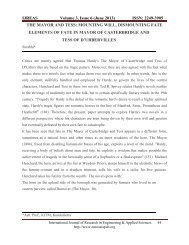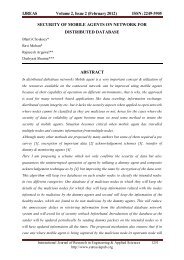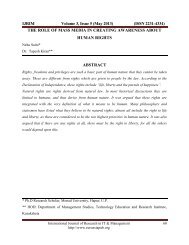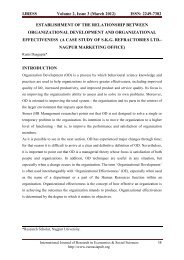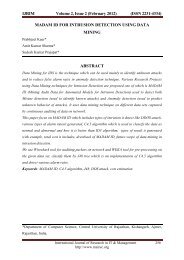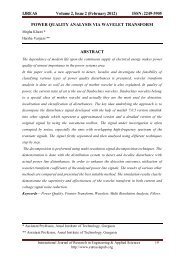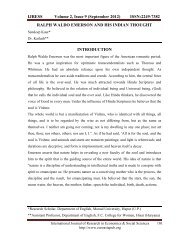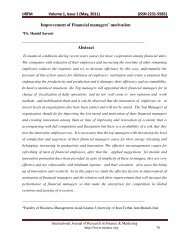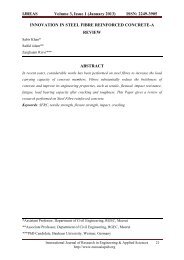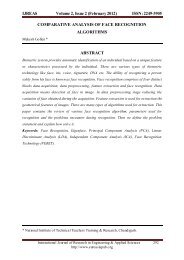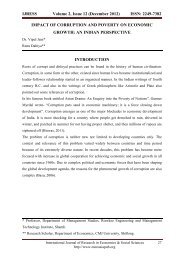implementation and design of 6t-sram with read ... - Euroasiapub.org
implementation and design of 6t-sram with read ... - Euroasiapub.org
implementation and design of 6t-sram with read ... - Euroasiapub.org
You also want an ePaper? Increase the reach of your titles
YUMPU automatically turns print PDFs into web optimized ePapers that Google loves.
IJREAS Volume 2, Issue 5 (May 2012) ISSN: 2249-3905IMPLEMENTATION AND DESIGN OF 6T-SRAM WITH READ ANDWRITE ASSIST CIRCUITSM. Adiseshaiah*D. Sharath Babu Rao**V. Venkateswara Reddy***ABSTRACTIn today’s world high performance workstations <strong>and</strong> servers dem<strong>and</strong>s fast memory accesstimes to keep up <strong>with</strong> heavy work load imposed upon them. If we assume that one <strong>of</strong> the goals<strong>of</strong> main memory technology is to produce a high bit density component, a part that requiressix transistors per cell may not be the best choice. Many <strong>of</strong> the researchers <strong>and</strong> companieshave been tackling the various problems that accompany the scaling. However, the transistorminiaturization also introduces many new challenges in very large-scale integrated (VLSI)circuit <strong>design</strong>. In the sub-100-nm CMOS generation, a large local V th variability degradesthe 6T-SRAM cell stability, so that we have to consider this local variability as well as theglobal variability to achieve high-yield SRAM products. Therefore, we need to employ someassist circuits to exp<strong>and</strong> the SRAM. The SRAM <strong>with</strong> 120nm technology technique the poweris 13.243mW <strong>and</strong> the SRAM <strong>with</strong> 65nm technology technique is 3.821mW. The total powersaving is 71.14%*Assistant Pr<strong>of</strong>essor, Department <strong>of</strong> ECE, Ananthalakshmi Institute <strong>of</strong> Technology,Ananthapur, A.P**Lecturer, Department <strong>of</strong> ECE, JNTU College <strong>of</strong> Engineering <strong>and</strong> Technology, Anantapur(DT), A.P***Associate Pr<strong>of</strong>essor,Department <strong>of</strong> ECE, Ananthalakshmi Institute <strong>of</strong> Technology,Ananthapur, A.PInternational Journal <strong>of</strong> Research in Engineering & Applied Sciences 36http://www.euroasiapub.<strong>org</strong>
IJREAS Volume 2, Issue 5 (May 2012) ISSN: 2249-39051. INTRODUCTIONFast memory access times are essential to cater the heavy workload needs imposed on PCs<strong>and</strong> work stations. With many users <strong>of</strong> PCs <strong>and</strong> work stations connected to local areanetwork (LAN) <strong>and</strong> wide area networks (WAN), the need for fast memory access is essentialDRAM operating fast page made <strong>of</strong>fer some relief for the “access time blues” CMOSTechnology has progressed rapidly <strong>with</strong> regard to Moore’s Law. Many researchers <strong>and</strong>companies all over the world have been tackling the various problems that accompany thescaling. Now a day the aggressive scaling <strong>of</strong> the transistor size drastically affects SRAMdevices, which are widely used in many digital chips such as cache <strong>and</strong> so on. This is becausethe SRAM cell generally employs the smallest transistor size in each technology generationto achieve a smaller chip size. Figure1 shows that the trend <strong>of</strong> six-transistor 6T-SRAM cellsize from 180-nm technology downward.Figure 1 Technology versus SRAM Cell SizeThe SRAM cell size shrinks by about 50% as one generation <strong>of</strong> technology advances. In 65-nm technology, SRAM cell sizes <strong>of</strong> about 0.5 µm2 have al<strong>read</strong>y been reported. In the 65nmCMOS generation, a large local V th variability degrades the 6T-SRAM cell stability. The V thvariability is divided into local <strong>and</strong> global components. The local V th variability occurs due t<strong>of</strong>luctuations <strong>of</strong> the doped impurities, while the global V th variability occurs mainly due to themanufacturing process. V th variability occurs mainly due to the manufacturing process, whichleads to variations in the MOS transistor’s physical dimensions such as gate length (L), gatewidth (W) <strong>and</strong> gate oxide thickness. As the transistor size shrinks <strong>with</strong> the advance <strong>of</strong>technology, because the accuracy <strong>of</strong> the physical dimensions is improved due to the advance<strong>of</strong> manufacturing equipment, then the global V th variability is mostly maintained..International Journal <strong>of</strong> Research in Engineering & Applied Sciences 37http://www.euroasiapub.<strong>org</strong>
IJREAS Volume 2, Issue 5 (May 2012) ISSN: 2249-3905Figure 2 Plot <strong>of</strong> SRAM nMOS transistors <strong>of</strong> 90-nm <strong>and</strong> 65-nm technologiesFig.2 shows the sigma <strong>of</strong> the local V th variability <strong>of</strong> SRAM nMOS transistors using 90-nm<strong>and</strong> 65-nm technologies the local V th variability is in proportion to the inverse square root <strong>of</strong>the transistor channel area LW. If the transistor size shrinks in accordance <strong>with</strong> the advance<strong>of</strong> technology, the sigma <strong>of</strong> the local Vth variability increases. This indicates that scalingdegrades the local V th variability. In 65-nm technology, it is difficult to keep a sufficientoperating margin using only the write assist circuitry <strong>and</strong> it is essential to use both <strong>read</strong> <strong>and</strong>write assist circuitry.II. IMPLEMENTATION OF SRAMThis chapter gives the detailed <strong>implementation</strong> <strong>of</strong> SRAM, the circuitry involved in <strong>design</strong>ingthe SRAM <strong>and</strong> the operation <strong>of</strong> each block in the <strong>design</strong>.A. ArchitectureThe block diagram <strong>of</strong> the SRAM chip is shown in Figure3. The core memory (32 bit) isarranged in an 8x4 array <strong>of</strong> 6-transistor (6T) SRAM memory cells. The square layout isefficient in terms <strong>of</strong> silicon area. It also provides a balanced bit line <strong>and</strong> word linecapacitance for optimal access time.Figure 3 Block diagram <strong>of</strong> the SRAMInternational Journal <strong>of</strong> Research in Engineering & Applied Sciences 38http://www.euroasiapub.<strong>org</strong>
IJREAS Volume 2, Issue 5 (May 2012) ISSN: 2249-3905B. Sense amplifierFigure4 shows the circuit schematic <strong>of</strong> the bit line sense amplifier. A cross-coupled inverterlatch is popular in low power <strong>design</strong>s due to negligible static power consumption. Typically,this type <strong>of</strong> sense amplifier detects a voltage difference <strong>of</strong> one tenth <strong>of</strong> the V DD . However, thepower consumption is still higher for this kind <strong>of</strong> sense amplifier because it requires that thecurrent source turn on slightly before the voltage swing is applied. Therefore, the currentsource is on for this extra delay <strong>and</strong> consumes static current [1], [5].Figure 4 Schematic <strong>of</strong> the Bit Line Sense Amplifier Circuit.Normally the Pre <strong>and</strong> SAE signals are low. Hence the bit lines are pre charged to V DD <strong>and</strong> theinternal nodes <strong>of</strong> the sense amplifier follow the bit line voltage (V DD ) but the sense amplifierdoes not operate (no path to ground). During a <strong>read</strong> operation, the Pre signal is pulled high<strong>and</strong> one <strong>of</strong> the bit lines discharges. After a small time delay when the BL discharges to avoltage low enough to be detected by the sense amplifier (typically one tenth <strong>of</strong> the V DD ),SAE signal is pulled high. This activates the sense amplifier <strong>and</strong> disconnects the internalnodes <strong>of</strong> the sense amplifier from the bit lines. Now the internal nodes <strong>of</strong> the sense amplifierreach the rail-to-rail swing <strong>and</strong> the data is latched by a delayed version <strong>of</strong> the SAE signal(Sel_latch signal) as explained in section C.C. Multiplexer, latch <strong>and</strong> output driver cellFigure5 shows the circuit <strong>of</strong> multiplexer, latch <strong>and</strong> output driver cell. It is similar to theDMUX cell. In this case, we have used just a pass transistor instead <strong>of</strong> using a transmissiongate at the input. Although the pass transistor introduces a Vt drop, the voltage swing isrestored due to the positive feedback mechanism. In this case, the static power dissipation isvery small because the feedback element does not conduct only for a small amount <strong>of</strong> time(Sel_latch <strong>and</strong> Sel_latchc are pulse signals). Sel_latch is a delayed version <strong>of</strong> sense amplifierInternational Journal <strong>of</strong> Research in Engineering & Applied Sciences 39http://www.euroasiapub.<strong>org</strong>
IJREAS Volume 2, Issue 5 (May 2012) ISSN: 2249-3905enable (SAE) signal. Similar to the DMUX, in this case the 16-bit output data word isselected by the column decoder outputs [1], [5].Figure 5 Circuit Schematic <strong>of</strong> the MUX, Latch <strong>and</strong> Output Driver CellD. Demultiplexer, latch <strong>and</strong> input data driver cellFigure 6 shows the circuit schematic <strong>of</strong> the demultiplexer (DMUX), latch <strong>and</strong> input datadriver cell. The demultiplexer is implemented in pass-transistor logic due to low-transistorcount <strong>and</strong> fast operation. Since the input data can be '0' or '1', a transmission gate is usedinstead <strong>of</strong> a NMOS pass transistor. The transmission gate is controlled by the columndecoderoutputs.The column decoder generates both the select signals <strong>and</strong> their complements. The latch isused to retain the data when the cell is not selected (D0 = '0'). The latch is implemented usingtwo cross-coupled inverters <strong>and</strong> a transmission gate. The data is stored due to positivefeedback action similar to the conventional SRAM cell. When the data is written in thememory (WE = '1'), the transmission gate disconnects the cross-coupling mechanism <strong>of</strong> thelatch. At this moment the input data (Din) is transparent to the BL provided the select signalis present (D0 = '1').Figure 6 Circuit Schematic <strong>of</strong> the DMUX, Latch <strong>and</strong> Input Driver CellInternational Journal <strong>of</strong> Research in Engineering & Applied Sciences 40http://www.euroasiapub.<strong>org</strong>
IJREAS Volume 2, Issue 5 (May 2012) ISSN: 2249-3905In the Figure 6 BLc is the complement <strong>of</strong> Bit line, D is the input to the D Latch <strong>and</strong> Dc is thecomplement to it, WEc is the complement <strong>of</strong> Write Enable. As soon as the WE signal goesaway, the transmission gate conducts <strong>and</strong> the data is latched by the positive feedbackmechanism. Instead <strong>of</strong> transmission gates, simple NMOS pass transistors can also be used toachieve the same operation. However, an NMOS does not transfer a logical high faithfully. Itinserts a voltage drop <strong>of</strong> Vt, the threshold voltage <strong>of</strong> the transistor under the body effect(source terminal is at a higher voltage than the substrate). This reduced swing goes to theinput <strong>of</strong> the inverter <strong>and</strong> causes a static current from V DD to ground. Therefore, for the lowpower <strong>design</strong>, we have used the transmission gates. Since the bit lines are highly capacitive,large inverters are added along <strong>with</strong> the transmission gates to drive the BLs [1], [5].E. 3x8 Row DecoderThe row selection circuit decodes the row address <strong>and</strong> activates one single row. This row isshared by all word line signals <strong>of</strong> the row. The row selection circuit is based on a multiplexercircuit. One line is asserted while all the other lines are at zero. In the row selection circuit forthe 8x4 array, we simply need to decode a two- bit address. The block diagram <strong>of</strong> the 3×8row decoder <strong>and</strong> its associated circuitry is as shown in Figure 7. The decoder selects one <strong>of</strong> 8lines, as per the address lines. The output <strong>of</strong> the decoder is fed to the rows <strong>of</strong> SRAM cells.The row decoder selects one <strong>of</strong> those rows, depending on the seven-bit address given to it.The entire system is explained in details later.A 1A 2A 33 x 8RowDecoder8 LinesSRAMCellsFigure 7 Block Diagram <strong>of</strong> 3 x 8 DecoderA normal decoder can be built using logic gates as we have studied in digital <strong>design</strong> courses.However, the normal decoder built using logic gates has the following drawbacks, asexplained for the column decoder too. The main problem is that the decoder will require avery large number <strong>of</strong> transistors. The address inputs will also have to be buffered to drive thishuge capacitance load. Another problem is that the power consumption <strong>of</strong> such a decoder willbe very high due to the large number <strong>of</strong> gates. SRAM chips are important components <strong>of</strong>embedded mobile systems, which generally run on batteries. It is very important to minimizethe power consumption to maximize the life <strong>of</strong> the battery. To overcome these problems, weInternational Journal <strong>of</strong> Research in Engineering & Applied Sciences 41http://www.euroasiapub.<strong>org</strong>
IJREAS Volume 2, Issue 5 (May 2012) ISSN: 2249-3905have used a dynamic NOR decoder. This structure reduces the number <strong>of</strong> transistors by half.It also increases the speed <strong>of</strong> the decoder <strong>and</strong> makes the layout simple <strong>and</strong> less timeconsuming.The structure <strong>of</strong> 3 to 8 row decoder is shown in Figure 9. In the Figure 8 A 0, A1,A2 are the inputs to the decoder <strong>and</strong> O 0 …O 7 are the output lines [1], [5].Figure 8 Schematic <strong>of</strong> 3 x 8 NOR row decoderF. Working Of NOR DecoderThe NOR decoder works like any other dynamic circuit. It requires a pre-charge cyclefollowed by the evaluation stage. These stages are as explained below. The ‘Pre-charge’ inputis asserted which turns ON the PMOS devices <strong>and</strong> all the outputs <strong>of</strong> the decoder go to V DD(Logic ‘1’). The decoder should not be <strong>read</strong> at this instant, since all the outputs will be atV DD . Evaluation Stage: Once the pre-charge is done, the PMOS device is turned OFF. Theoutputs will still be at Logic ‘1’, because the charge will be stored on the capacitors. Now theinputs are applied on the three address lines. The corresponding NMOS devices will beturned ON <strong>and</strong> the charged capacitor on that line will be discharged to ground. Thus, all,except one line will go to ground (Logic ‘0’). The line, which remains high, will be thedecoded line <strong>and</strong> this line will drive all the NMOS transistors on that line. Thus, the right datawill be available on the data line. This data will be given to the output data block, which willreturn the correct data to the outside world when the Out Enable signal is asserted. Theselected line will have to drive a number <strong>of</strong> transistors <strong>and</strong> so we will need a series <strong>of</strong> buffersto drive such a heavy load. The number <strong>of</strong> buffer stages required to drive the transistors,<strong>with</strong>out compromising on the speed [1], [5].G. 3x8-Column DecoderThe column address decoder shown in Figure 9 is similar to the row address decoder <strong>with</strong> theaddition <strong>of</strong> a pass transistor. The pass transistor is connected to the bit lines. The tree decoderportion <strong>of</strong> the column decoder is sometimes called a pre decode. An enable can be used hereas well. In the Figure 9 A 0, A 1 , A 2 are the inputs to the decoder <strong>and</strong> O 0 …O 7 are the outputlines.International Journal <strong>of</strong> Research in Engineering & Applied Sciences 42http://www.euroasiapub.<strong>org</strong>
IJREAS Volume 2, Issue 5 (May 2012) ISSN: 2249-3905Figure 9 the schematic <strong>of</strong> a 3x8-column decoderThe column decoder circuitry is <strong>design</strong>ed to select one out <strong>of</strong> 2 M columns <strong>of</strong> the RAM arrayaccording to an M-bit column address, <strong>and</strong> to route the data content <strong>of</strong> the selected bit line tothe data output. The tree based column decoder consisting <strong>of</strong> consecutive stages is shown inFigure 9. In this case, the pass transistor network is used to select one out <strong>of</strong> every two-bitline at each stage, whereas the column address bits drive the gates <strong>of</strong> the nMOS passtransistors.The advantage <strong>of</strong> tree-based decoder is that much reduced transistor count. The disadvantageis that large number <strong>of</strong> series connected nMOS passes transistors [1], [5].I.SRAM cell <strong>with</strong> when <strong>read</strong> fails.When the WL turns on node A will rise due to voltage divider action between M5 <strong>and</strong> M1. Ifthis level is higher than the trip point on <strong>of</strong> the INV (M3, M4) the latch will loose its statethen its <strong>read</strong> fails.Figure 11 Circuit <strong>of</strong> 6-T CMOS SRAM Cell when <strong>read</strong> failsInternational Journal <strong>of</strong> Research in Engineering & Applied Sciences 43http://www.euroasiapub.<strong>org</strong>
IJREAS Volume 2, Issue 5 (May 2012) ISSN: 2249-3905J. Read <strong>and</strong> Write assist circuit technique in 65nmFigure 12 Circuit Schematic <strong>of</strong> 6-T SRAM Cell <strong>with</strong> <strong>read</strong> & write assist circuitIn order to achieve a higher yield for SRAMs using the straight cell, we propose a <strong>read</strong>assist circuit. Figure shows this circuit. The <strong>read</strong> assist circuit improves the SNM by slightlylowering the word line (WL) level rather than the SRAM memory cell power supply [4]. TheWL level is held below the memory VDD. Read current is reduced, <strong>and</strong> write is moredifficult.VDD level <strong>of</strong> the bit cell above the WL voltage. This will increase the gate drive <strong>of</strong>the Pull-Down device <strong>and</strong> improve SNM. During a <strong>read</strong>, VDD <strong>of</strong> all columns must be raised.When the memory is inactive, the lower VDD will reduce leakage [6].III. Circuit ImplémentationA. 6T SRAM CellFigure 13 shows the schematic <strong>of</strong> a 6T SRAM Cell, In the Figure 14 the layout <strong>of</strong> this cell isshown <strong>and</strong> followed by its output in Figure 15.Figure 13 Schematic <strong>of</strong> 6T SRAM CellInternational Journal <strong>of</strong> Research in Engineering & Applied Sciences 44http://www.euroasiapub.<strong>org</strong>
IJREAS Volume 2, Issue 5 (May 2012) ISSN: 2249-3905The 6T SRAM cell shown in the above figure has two outputs BL <strong>and</strong> BLc <strong>and</strong> one inputWL. BL is real value <strong>and</strong> BLc is the complementary value.Figure 14 Layout <strong>of</strong> 6T SRAM cell in 120µm technologyThe layout is having six transistors <strong>and</strong> two metal lines lead the outputs. The ‘data’ <strong>and</strong>‘~data’ signals similar to ‘BL’ <strong>and</strong> ‘~BL’ in the schematic, ‘Word line’ are the ‘WL’ signal.Figure 15 Output <strong>of</strong> 6T SRAM Cell Layout in 120µm technologyB. 6T SRAM Cell <strong>with</strong> <strong>read</strong> <strong>and</strong> write assist circuitFigure 16 shows the layout <strong>of</strong> a 6T SRAM Cell <strong>with</strong> <strong>read</strong> <strong>and</strong> write assist circuit in 65nmtechnology, the operation <strong>of</strong> this module is discussed in Chapter II. Figure 17 shows theoutput <strong>of</strong> the layout <strong>of</strong> a SRAM Cell.International Journal <strong>of</strong> Research in Engineering & Applied Sciences 45http://www.euroasiapub.<strong>org</strong>
IJREAS Volume 2, Issue 5 (May 2012) ISSN: 2249-3905Figure 16 Layout <strong>of</strong> 6T SRAM cell in 65nm technologyIn the above layout, the inputs <strong>and</strong> outputs are same as that <strong>of</strong> the general 6T SRAM cell,extra inputs “bit line”, “~ bit line” is the gate input signal to the SRAM, <strong>and</strong> “clk” is the extrainputs for the <strong>read</strong> <strong>and</strong> write assist circuit.IV. RESULTSFigure 17 Output <strong>of</strong> 6T SRAM Cell Layout in 65µm technologyA. Layout for a 32 bit SRAMInternational Journal <strong>of</strong> Research in Engineering & Applied Sciences 46http://www.euroasiapub.<strong>org</strong>
IJREAS Volume 2, Issue 5 (May 2012) ISSN: 2249-3905Figure 18 Layout <strong>design</strong> <strong>of</strong> 32-bit SRAM in 120nmThe layout for 32 bit SRAM is shown in Figure 18 <strong>and</strong> the simulation results <strong>of</strong> the layout isshown in Figure 19. In this section, the <strong>design</strong> <strong>of</strong> SRAM <strong>design</strong>ed <strong>with</strong> 120nm technologyusing Micro wind Version 3.0 is shown. The waveforms thus shown in Figure 19 give a clearview <strong>of</strong> the address bits <strong>and</strong> the data bits. The layout obtained is the combination <strong>of</strong> all theindividual blocks discussed in Chapter III. All the basic modules are integrated to form a 32-bit SRAM. The layout, decoders <strong>with</strong> less number <strong>of</strong> transistors are chosen to optimize thearea.Figure 19 output <strong>of</strong> 32-bit SRAM in 120nm technologyFrom the Figure 19 it is evident from the waveforms that some data is written into thememory cells. The Word line[X], X=0,1… are the write logic signals corresponding to eachrow <strong>of</strong> the SRAM cell array. Bit line [BL] <strong>and</strong> ~Bit line [~BL] are the signals correspondingto the bit line signal <strong>and</strong> its complement. The complement <strong>of</strong> the signal is considered to makethe access <strong>of</strong> data faster since SRAM is used as cache memory. Data[X] <strong>and</strong> ~ Data[X],X=0,1,…. are the output data signals at each cell <strong>of</strong> the SRAM array.International Journal <strong>of</strong> Research in Engineering & Applied Sciences 47http://www.euroasiapub.<strong>org</strong>
IJREAS Volume 2, Issue 5 (May 2012) ISSN: 2249-3905B. Layout for a 32 bit SRAM in 65nm technologyThe layout for 32 bit SRAM in 65nm technology is shown in Figure 20 <strong>and</strong> the simulationresults <strong>of</strong> the layout is shown in Figure 21Figure 20 Layout <strong>design</strong> <strong>of</strong> 32-bit SRAM in 65nmThe Figure 20 is the layout <strong>of</strong> 32-bit SRAM <strong>design</strong>ed by incorporating the <strong>read</strong> <strong>and</strong> writeassist circuit in 65nm technology logic to the general SRAM circuit shown in the Figure 18.Figure 21 Output <strong>of</strong> 32-bit SRAM in 65nm technologyB. Comparison <strong>of</strong> powers dissipation <strong>of</strong> SRAM in 120nm & SRAM 65nmtechnologyNow the power dissipation, which was monitored on the output window <strong>of</strong> the practicallyimplemented for both the SRAM’s, one in 120nm <strong>and</strong> other is <strong>with</strong> 65nm technology shownbelow.Figure 22 shows the powers <strong>of</strong> SRAM <strong>with</strong> 120nm technology <strong>and</strong> it is 13.243mW. And theSRAM <strong>with</strong> 65nm technology is 3.821mW.International Journal <strong>of</strong> Research in Engineering & Applied Sciences 48http://www.euroasiapub.<strong>org</strong>
IJREAS Volume 2, Issue 5 (May 2012) ISSN: 2249-3905Figure 22 monitoring the power dissipation <strong>of</strong> SRAM in 120nm & 65nm technologyThe power dissipation have been monitored for both the SRAM’s, the monitored part <strong>of</strong> thepower dissipation is shown in Figure 22.V. CONCLUSIONSThe 65nm technologies SRAM is implemented <strong>with</strong> <strong>read</strong> <strong>and</strong> write assist circuit technique.The project has been very challenging since it includes functional validation, transistor sizing,<strong>and</strong> layout <strong>of</strong> various circuits. Full functionalities <strong>of</strong> all the <strong>design</strong> features have beenvalidated. Based on simulation results for the circuit it can be concluded that <strong>read</strong> <strong>and</strong> writeassist circuitry is effective controlling power dissipation. Finally, the power dissipation <strong>of</strong>both the circuits incorporated is compared. The future scope <strong>of</strong> this project is density <strong>of</strong> theSRAM circuit can be increased by using less transistor SRAM cells. The performance <strong>of</strong> themodule can be improved using low voltages. A 128 x 128 SRAM can be implemented usingthe basic module <strong>of</strong> this project. Speed <strong>of</strong> the SRAM can be improved by scaling down thetechnology.VI. REFERENCES[1] J. M. Rabaey, A. Ch<strong>and</strong>rakasan, B. Nikolic, “Digital Integrated Circuits, aDesign Perspective” Prentice-Hall India, second edition, 2003.[2] David.A.Hodges, Horace G Jackson, Resve A Saleh, “Analysis <strong>and</strong> Design <strong>of</strong>Digital Integrated Circuits” Tata Mc Grawhill. Third edition 2004.[3] M. K<strong>and</strong>a, K.Takahashi, H. Oyamatsu, N. Nagashima, <strong>and</strong> M. Kakumu, “Highlystable 65 nm node (CMOS5) 0.56 _m SRAM cell <strong>design</strong> for very low operationvoltage,” in Symp. VLSI Technology 2003Dig. Tech. Papers, Jun. 2003.[4] K. Zhang, U. Bhattacharya, D. Murray, Y.Wang, B. Zheng, <strong>and</strong> M. Bohr, “A 3-GHz 70-Mb SRAM in 65-nm CMOS technology <strong>with</strong> integrated column-basedInternational Journal <strong>of</strong> Research in Engineering & Applied Sciences 49http://www.euroasiapub.<strong>org</strong>
IJREAS Volume 2, Issue 5 (May 2012) ISSN: 2249-3905dynamic power supply,” IEEE J. Solid-State Circuits, vol. 41, no. 1, pp. 146–151,Jan. 2006[5] A. P. Ch<strong>and</strong>rakasan el al., “Low-power CMOS digital <strong>design</strong>,” IEEE Journal <strong>of</strong>Solid-state Circuits, Vol. 27, pp. 473-484, Apr. 1992.[6] Shigeki Ohbayashi, Makoto Yabuuchi, Koji Nii, Yasumasa Tsukamoto, SusumuImaoka,Yuji Oda, Tsutomu Yoshihara, Motoshige Igarashi, Masahiko Takeuchi,Hiroshi Kawashima,Yasuo Yamaguchi, Kazuhiro Tsukamoto, Masahide Inuishi,Hiroshi Makino, Koichiro Ishibashi,<strong>and</strong> Hir<strong>of</strong>umi Shinohara “A 65-nm SoCEmbedded 6T-SRAM Designed for Manufacturability With Read <strong>and</strong> WriteOperation Stabilizing Circuits” IEEE Journal Of Solid-State Circuits, Vol. 42,NO. 4, APRIL 2007International Journal <strong>of</strong> Research in Engineering & Applied Sciences 50http://www.euroasiapub.<strong>org</strong>



